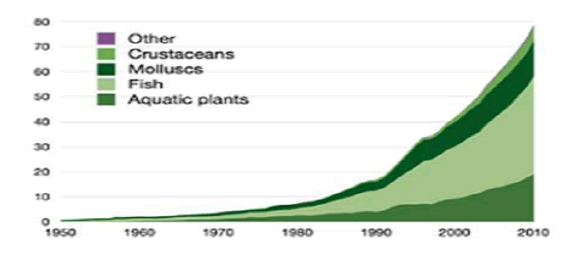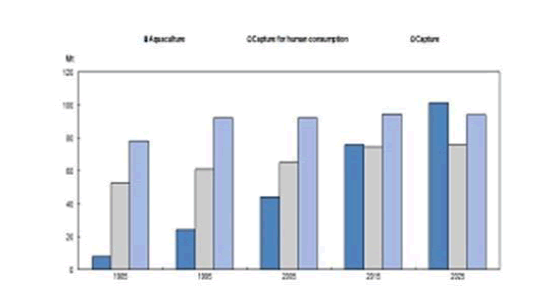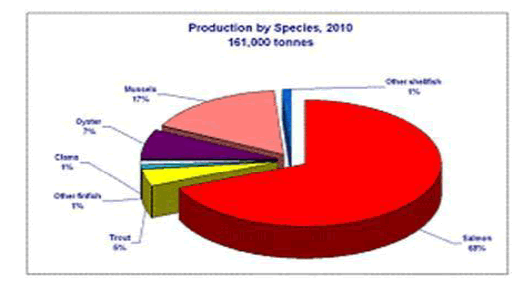Fisheries and Aquaculture Journal
Open Access
ISSN: 2150-3508
+44 1478 350008
ISSN: 2150-3508
+44 1478 350008
Market Analysis - (2021)
From olden days, fishing from lakes, rivers and oceans has been a major source of food, provider of employment and other economic benefits for humanity. Aquaculture is counted be probably the fastest growing food-producing sector in the world currently. The growing concern and awareness about the health advantages and nutritional value associated with seafood surge its consumption. Also, rising demand for fish oil in various industries like healthcare, pharmaceuticals, food and dietary supplements among others further contribute to the market growth significantly. The combined result of the growth of aquaculture worldwide and the expansion in world population is that the average annual per capita supply of food fish for human consumption has grown ten times in the past 2 decades.
Aquaculture is the quickest developing food production system in the global due to the lack of naturally available varieties of fisheries harvested in natural environments. The increasing consciousness of the dietary benefits and nutritional value associated with seafood has accelerated its consumption. Aquatic products, particularly cultivated salmon and shrimps, are exceptionally nutritious sources of food, consisting of important proteins, vitamins A, B, D, and Niacin, minerals like iron, iodine, zinc, and osphorus. These foods also have a significant source of Omega-3 fatty acids for example docosahexaenoic acid (DHA) and eicosapentaenoic acid (EPA). Worldwide aquaculture and Fisheries market values at $160.98 billion in 2017 and is expected to grow $224.2 billion by 2022 growing at a CAGR of 5.15 percent during the forecast period. As per reports an annual growth rate for the worldwide aquaculture industry of 4.46 percent for the 5year period between 2018 and 2022. In 2018, the report predicts a CAGR of 3.72; a CAGR of 4.12 percent in 2019; 4.50 percent in 2020; 4.83 percent in 2021; and 5.15 percent in 2022.
Worldwide Aquaculture industry profile gives top-line subjective and quantitative rundown data including: showcase estimate (esteem and volume 2013-17, and conjecture to 2022). The profile likewise contains depictions of the mainplayers including key monetary measurements and examination of focused weight inside the market. Fundamental asset for best line information and examination covering the Global aquaculture showcase. Incorporates showcase size and division information, literary and graphical examination of market development patterns, driving organizations and macroeconomic data. The aquaculture business is characterized as generation through the cultivating of sea-going living beings, in both inland waters and marine territories, including: freshwater angle, marine fish, diadromous fish, molluscs, and scavangers. The worldwide aquaculture industry had add up to incomes of $226,487.7m in 2017, speaking to a compound yearly development rate (CAGR) of 5.5% somewhere in the range of 2013 and 2017. Industry creation volume expanded with a CAGR of 4.7% somewhere in the range of 2013 and 2017, to achieve a sum of 77,931.9 thousand tons in 2017. The Chinese aquaculture industry is by a wide margin the biggest internationally, representing 66.8% of the worldwide esteem and 70.8% of volume in 2017. Norway is the biggest salmon maker comprehensively. Chile is the second biggest salmon maker on the planet after Norway, representing around a four.

Use the Five Forces investigation to decide the focused power and along these lines allure of the global aquaculture market. Leading organization profiles uncover subtle elements of key aquaculture showcase players' worldwide tasks and money related performance. Add weight to introductions and pitches by understanding the future development prospects of the Global aquaculture advertise with multiyear estimates by both esteem and volume."The aquaculture items advertise is anticipated to develop at a CAGR of 7.2% regarding an incentive somewhere in the range of 2018 and 2023." The aquaculture items showcase is anticipated to develop at a CAGR of 7.2% from 2018, to achieve USD 42.56 billion by 2023 from USD 30.10 billion out of 2018. Aquaculture items are hardware and crude materials that go about as contributions for raising and cultivating of oceanic creatures and plants. These items improve normal stocking and nourishing of amphibian creatures and plants and offer assurance from predators. A portion of the gear and supplies considered in this investigation incorporate regulation hardware, water administration hardware, synthetic substances, pharmaceuticals, and manures. The interest for the aquaculture items industry is anticipated to be on the ascent, attributable to variables, for example, decreasing in the measure of caught angle, expanding populace, and ascend in utilization because of the wholesome estimation of fish."The pharmaceuticals fragment
in the aquaculture items showcase is anticipated to develop at the most noteworthy rate through the conjecture time frame. An extensive variety of anti-microbial, against microbial, including antibacterial (anti-infection agents), hormonal antibodies, soporifics, shades, minerals, and vitamins are utilized to dodge or control ailments in aquaculture.

The expanding R&D in the pharmaceuticals portion has encouraged higher acknowledgment of medications, sedated feed, and antibodies into theprovincial markets, particularly in created nations, for example, the US and Canada. The worldwide market for pharmaceutical use in aquaculture is likewise seeing some key patterns.
For example, in the US, the utilization of additional mark drugs is allowed in aquaculture under the direction and supervision of an authorized veterinarian. There has been a developing reception of in-feed pharmaceutical for fish to keep the vast scale spread of sicknesses. The primary point here is to cure sound fish and keep any sort of contact with contaminated fish. The interest for cured aqua feed is expanding in sorted out fish cultivates crosswise over Europe, given the restricted utilization of anti-microbial over the locale

"The Asia Pacific market is anticipated to command the sea-going creatures fragment in the aquaculture items showcase amid the audit time frame." The oceanic creatures portion in the aquaculture items showcase, by species, is sectioned into shellfish, molluscs, finfish, and others. According to the FAO, Asia was the biggest maker of sea-going creatures on the planet with a volume of 71.5 billion tons (around 89.4% of the world) in 2017. As indicated by a similar source, Asia has the biggest inland and marine culture development of sea-going plants, with freshwater culture getting over half and marine water securing over 30% of the aggregate sea-going creature development all inclusive. Such factors have incited a few aquaculture item producers to put resources into the area, consequently expanding the industrialization of aquaculture. These variables are driving the market development in Asia Pacific for oceanic creature generation.
Copyright: This is an open access article distributed under the terms of the Creative Commons Attribution License, which permits unrestricted use, distribution, and reproduction in any medium, provided the original work is properly cited.